Recent Posts
-
From IDR 450K
Per Person
Kintamani Cycling Tour
The Kintamani cycling tour package is a popular tourist activity on the Indonesian island of Bali. It allows tourists to discover Bali’s magnificent countryside and gorgeous surroundings by cycling through villages, rice fields, and woods. The journey is ideal for nature lovers, adventure seekers, and those interested in learning about Balinese culture.
The journey normally begins with a hotel pickup, followed by a picturesque drive up to the Kintamani highlands. Visitors may enjoy a stunning view of Mount Batur, an active volcano, and the tranquil Lake Batur from here. The bike trip begins after a quick safety briefing and equipment check.
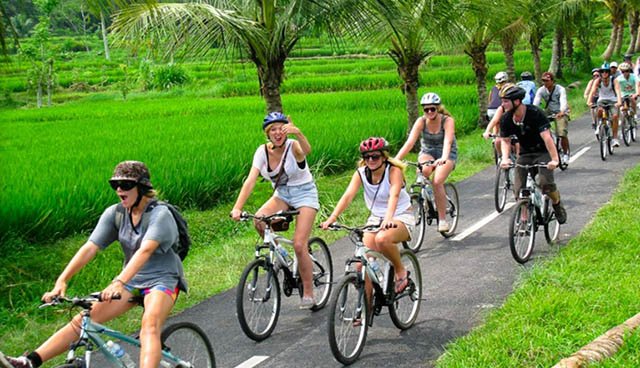
One of the tour’s highlights is a stop at a traditional Balinese home complex, where guests may get a sight of the native way of life and discover the Balinese people’s traditions and beliefs. As part of the tour, guests will also visit a coffee farm where they will get the opportunity to try some of Bali’s best coffee and tea.
Cycling through beautiful rice paddies and verdant woodlands, taking in the fresh air and breathtaking scenery, is part of the journey as it moves on. A delectable Balinese lunch and a ride back to the hotel mark the tour’s conclusion.
The Kintamani cycling tour package is a wonderful opportunity to discover Bali’s picturesque scenery and rich culture. Visitors may enjoy an exciting day of exploration and adventure with a well-thought-out itinerary and knowledgeable guides.
The Kintamani highlands are one of Bali’s most famous tourist destinations. The highlands, located at an elevation of 1,500 meters above sea level, provide tourists with a breathtaking view of Mount Batur and Lake Batur, one of Bali’s largest crater lakes.
From the Kintamani highlands, the view of Mount Batur is spectacular. Mount Batur is an active volcano that has erupted multiple times in the past, the most recent being in 2000. Mount Batur is a popular hiking destination, despite its active condition, and many people travel to Bali particularly to trek up to its peak.
Another natural beauty visible from the Kintamani highlands is Lake Batur, which is located at the base of Mount Batur. The lake is a big crater lake with a circumference of approximately 7 kilometers that is surrounded by hills and mountains. Guests may enjoy the tranquillity of the surrounding nature while taking in the placid beauty of Lake Batur from the hills.
Apart from the breathtaking views of Mount Batur and Lake Batur, the Kintamani highlands provide visitors with a cool and refreshing atmosphere that is a welcome relief from Bali’s tropical heat.
During the Kintamani cycling tour, tourists will have the option to visit a Traditional Balinese home compound, which provides insight into the Balinese people’s native culture, customs, and beliefs.
The Balinese home complex is a typical family housing characterized by its unique architecture and style. It usually consists of numerous structures, such as a main home, a family temple, a kitchen, and a rice barn. The houses are composed of wood and bamboo and have thatched roofs as well as elaborately carved doors and windows. The family temple, located in the middle of the courtyard, serves as the house’s spiritual core and is utilized for daily sacrifices and prayers.
A local family will be greeting visitors and accompanying them through the complex, providing insight into their everyday lives and rituals. Guests will learn about the significance of family and community in Balinese culture and see the traditional way of life that has been perpetuated for centuries.
Visitors to the traditional Balinese home compound can also learn about Balinese beliefs and spiritual practices. Guests will learn about the relevance of religion in Balinese culture, as well as the significance of daily offerings and rites done at the family temple.
The tour of the Balinese house complex also includes a typical Balinese lunch provided in a family-style setting. Guests will be able to sample a range of local delicacies cooked with fresh ingredients and traditional Balinese spices.
The Traditional Balinese home compound is a one-of-a-kind and enlightening experience that provides guests with an insight into the Balinese people’s lifestyle, customs, and beliefs. It is an excellent method to learn about Bali’s rich cultural heritage and to engage with the local people in a meaningful way.
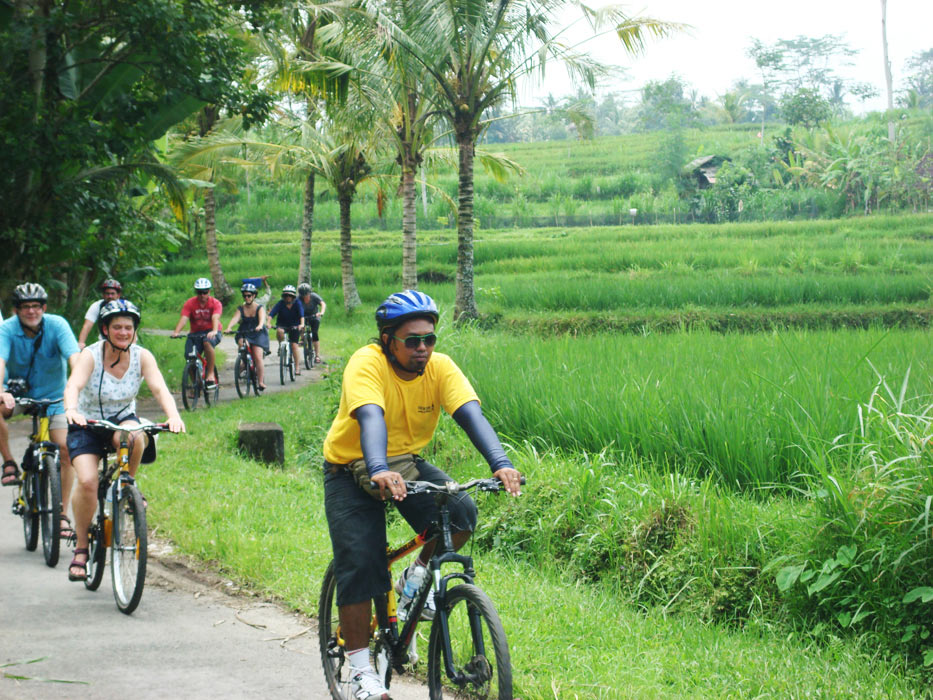
The Kintamani cycling tour takes you through the beautiful rice terraces and forests typical of the Bali scenery. The journey allows guests to take in Bali’s natural beauty while also enjoying the fresh air and tranquil ambiance of the countryside.
Bali’s rice paddies are a reflection of the island’s agricultural culture. The rice terraces are organized in a tiered pattern, creating a spectacular visual scene. Terraces are carved into the hillsides, resulting in a sequence of steps that flow down the slopes. The surrounding woodlands frame the green fields of the rice paddies, adding to the splendor of the environment.
Travelers will ride through the beautiful forests that cover most of Bali in addition to the rice terraces. The forests sustain an extensive range of plant and animal species and serve as a major source of oxygen and natural resources for the island. The journey through the trees allows tourists to take in the fresh air and relax in the calm and tranquillity of their surroundings.
The sounds of nature, such as birds singing and leaf rustling, will accompany tourists as they ride through the rice paddies and forests. The highlands’ cool and refreshing atmosphere adds to the whole experience, offering an escape from the tropical heat of the island’s coastal sections.
See Bali’s natural beauty and rich cultural legacy on the Kintamani cycling tour, a memorable journey. This tour is a must-do for anybody wanting to discover Bali’s hidden jewels since it offers breathtaking views of Mount Batur and Lake Batur, a trip to a traditional Balinese housing compound, and a ride through beautiful rice terraces and woods.
You will not only have the opportunity to see the gorgeous environment, but you will also learn about the Balinese people’s way of life, traditions, and beliefs. Your day of exploration and adventure will be made pleasant by affable and knowledgeable guides, who will also provide you with a comprehensive cultural experience.
So why wait? Discover the wonder of Bali’s scenery and culture by booking your Kintamani cycling tour right away. With so much to see and do, this tour is guaranteed to leave you with lifelong memories. Don’t pass up this chance to visit one of the most breathtaking places on earth.
Tour Itinerary
07.00 – Pick up at your hotel
09.00 – Breakfast at Kintamani with a view of Mount Batur volcano
10.00 – Go to starting point of Kintamani Cycling
10.30 – Enjoy the downhill Kintamani Cycling Tour
13.30 – Lunch
14.30 – Back to the hotel
16.00 – Arrive at the hotel
Tour Prices :
1 Person : IDR 950.000
2 Persons : IDR 700.000/person
3 Persons : IDR 600.000/person
4 Persons : IDR 550.000/person
5 Persons : IDR 500.000/person
6 Persons : IDR 450.000/person
Area Covered for Pick Up
Seminyak, Legian, Kuta, Nusa Dua, Jimbaran, Pecatu, Sanur, Ubud, Canggu, Denpasar, Benoa Harbour, Airport.
Please contact us for pick up in different area.
Booking and Payment
- Fill in and submit the booking form
- Payment is Cash to your driver
-
DepartureHotel/ Villa
-
Departure Time6:00 AM
-
Return Time6:00 PM
-
IncludedPrivate tourComfortable Car with Air ConditionerSpeaking English DriverPetrol for carSafety and Well Maintenance Equipment'sBreakfast at KintamaniCoffee break with balinese snackProfessional cycling guidesLunchParking feesMineral waterGovernment taxesInsurance
-
Not IncludedPersonal expenses
Similar Tours
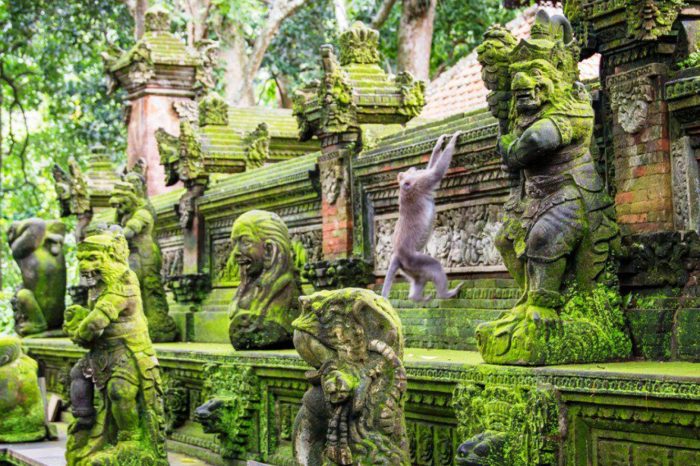
IDR 650K
Ubud Tour
Welcome to Ubud Tour package. Discover the stunning beauty and rich culture of this one of Bali’s most popular destinations. Our tours aim to give you a comprehensive experience of Ubud, from traditional dances and handicrafts to stunning natural scenery.
Located in the heart of Bali, Ubud is often referred to as the ‘cultural center’ of the island. Surrounded by rice fields and lush rainforests, the city exudes a calm and peaceful atmosphere that attracts tourists from all over the world. Ubud is also known for its rich history, which is reflected in the many temples, palaces, and museums located throughout the city. The Ubud Tour Package is the perfect way to explore this vibrant city and experience its unique culture. We have carefully put together an Ubud tour itinerary that includes some of Ubud’s must-see attractions, each with its own special meaning. From Barong and Keris dance performances to the Ubud market, you can experience the best of Ubud in just one day.
Your knowledgeable tour guide will provide you with detailed information about Ubud’s history and culture, allowing you to learn about each destination on a deeper level. Whether you are interested in traditional handicrafts, stunning natural scenery, or Balinese history and culture, our Ubud tour packages have something for everyone. Join this unforgettable Ubud tour and experience the beauty and culture of one of Bali’s most fascinating cities. We can’t wait to show you what makes Ubud so special!
Place to Visit
Barong and Keris Dance Performance
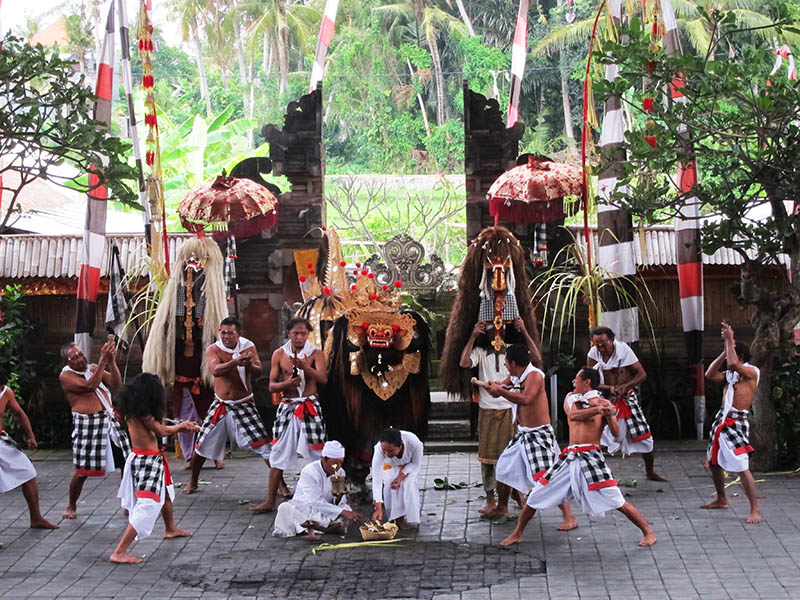
The Barong and Keris dance performance is a traditional Balinese dance and is considered one of the most important cultural performances on the island. This dance performance is usually performed in temples and public places during traditional ceremonies, festivals, or special occasions.
Barong is a mythical creature representing good in Balinese mythology and Keris is a traditional Indonesian dagger representing evil. The dance is a battle between Barong and Keris, and Barong tries to protect people from Keris’ malice. Performances typically begin with character introductions, followed by a battle between Barong and Keris. The dance is accompanied by traditional Balinese music played on gamelan instruments, further enhancing the magical atmosphere of the performance. The dancers wear elaborate costumes and their movements are graceful and synchronized.
Celuk Village
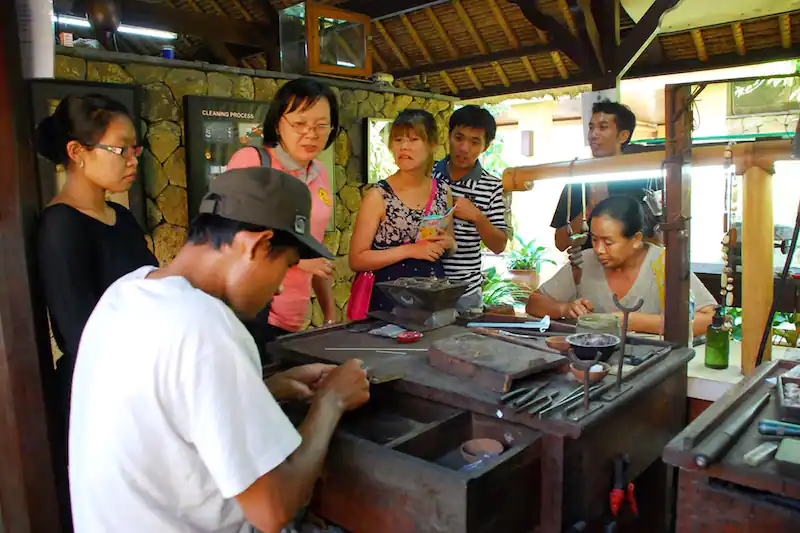
Celuk Village is a must-visit destination for those who are interested in Balinese culture and traditional crafts. This small village is known for its silver and gold jewelry, which has been made here for generations.
The village is located in the Gianyar Regency, approximately 5 km from the center of Ubud. It’s easily accessible by car or motorbike, and there are plenty of parking spaces available. Once you arrive, you’ll notice that most of the shops in the village specialize in silver and gold jewelry making.
The traditional jewelry-making process is fascinating to watch. You’ll see skilled artisans working with a range of tools, such as hammers, pliers, and filers, to shape the metal into intricate designs. They use traditional techniques such as hand engraving, filigree, and granulation to create beautiful pieces of jewelry that are unique to the village.
If you’re interested in purchasing souvenirs, this is the perfect place to do so. You’ll find a wide variety of jewelry items, including earrings, necklaces, bracelets, and rings, all at reasonable prices. Most of the shops also offer custom-made jewelry, so you can even design your own unique piece.
It’s recommended to spend at least an hour in the village to explore and shop around. You’ll have the opportunity to browse through the different shops, watch the artisans at work, and even try your hand at making jewelry yourself.
Tegenungan Waterfall
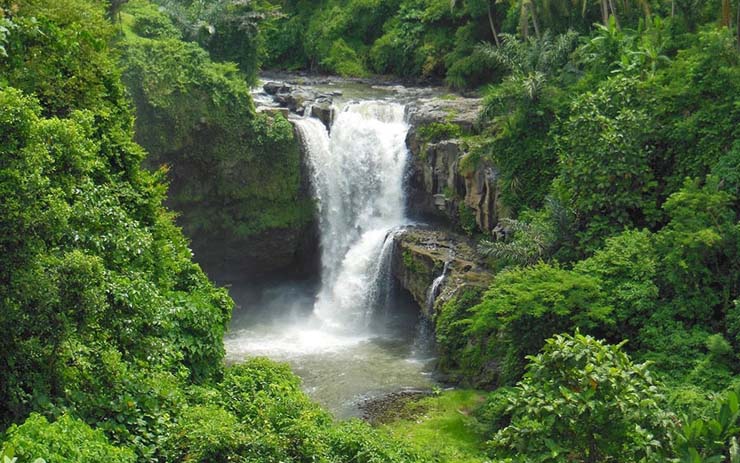
One of Bali’s most stunning waterfalls, Tegenungan Waterfall is situated in the Tegenungan area. Its outstanding natural beauty is created by its location in a luxuriant jungle environment, which is surrounded by vegetation and rocks.
The waterfall is only around 10 km from the city of Ubud and is conveniently reachable by vehicle or motorcycle. The waterfall is only a short distance away from there through a staircase.
It’s crucial to wear comfortable shoes and use caution because the descent to the waterfall might be rather arduous. The journey is worthwhile, though, because of the stunning landscape along the way. A breathtaking view of the waterfall pouring down from a height of around 15 meters awaits you once you reach the bottom.
The chance to swim and unwind in the cold, soothing water of Ubud Tegenungan Waterfall is one of its best features. Visitors can swim and enjoy the natural beauty of the surroundings in a tiny pool at the base of the waterfall. It’s vital to keep in mind that the water can be rather deep, therefore being a confident swimmer is advised.
Plan on spending at least an hour or two swimming and relaxing in order to really enjoy the waterfall experience. Furthermore close are a few little cafés and food stands where you may have a snack or drink.
The Tegenungan Waterfall is a stunning and tranquil natural sight that should not be overlooked when joining the Ubud tour. It’s the ideal place to relax and get in touch with nature thanks to the breathtaking environment, swimming, and relaxing options.
Tegalalang Rice Terrace
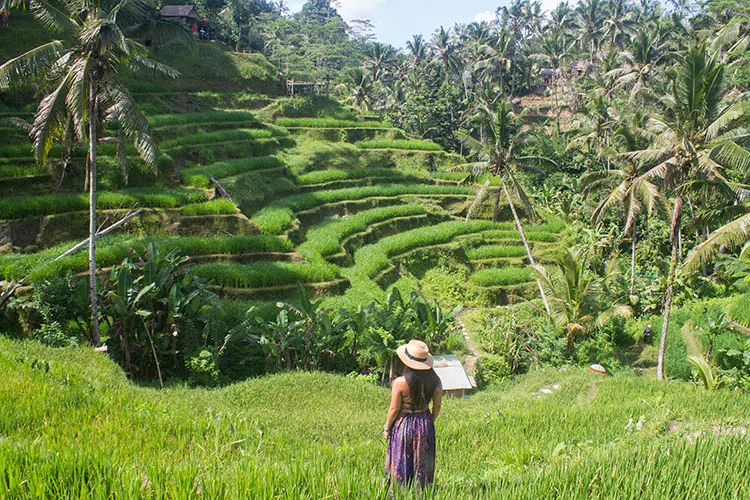
The Tegalalang rice terrace is one of Bali’s most famous and beautiful landscapes. The island’s long history of rice farming is attested to by the rice terraces, a cultural icon of Bali.
A complex irrigation system that has been passed down through generations of Balinese farmers was used to build the rice terraces. The method uses small channels to redirect water from rivers and streams into rice paddies. The procedure makes sure that the rice paddies have the right amount of water and nutrients for growing strong crops.
Visitors to the Tegalalang Rice Terrace have the chance to tour the terraces and discover how rice is traditionally farmed. The scenery makes for a beautiful backdrop for photos, thus there are numerous photo chances accessible.
There is an optional activity—the traditional Balinese swing—available for those seeking a distinctive experience. Visitors may swing above the rice terraces and take in the beautiful vistas from a unique vantage point thanks to the swing’s bamboo and rope construction.
It is advised to set aside at least an hour or two to tour the rice terraces and appreciate the natural beauty of the area. Also close are a number of local cafes and gift shops where tourists may try local food and buy souvenirs.
In general, those who are interested in Balinese culture and natural beauty should visit the Ubud Tegalalang rice terrace. It’s the ideal place to unwind and interact with the island’s rich cultural heritage thanks to its fascinating history, beautiful landscapes, and intriguing optional activity.
Ubud Monkey Forest
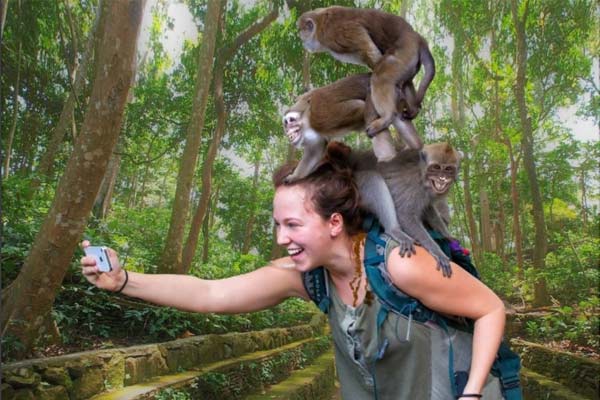
The Ubud Monkey Forest is a sanctuary in the center of Ubud where a robust monkey population lives. The park, a well-liked tourist destination, gives guests the chance to get up and personal with these amusing animals.
More than 700 Balinese long-tailed macaques, a local type of monkey, reside in the sanctuary. Visitors are cautioned to keep their distance from the monkeys and to refrain from petting or establishing eye contact with them. While being friendly in general, monkeys are still wild animals and can become hostile if provoked.
The park and its several temples, which are steeped in Balinese culture and history, may be explored by visitors. The temples are ornately carved and sculptured, providing tourists with an insight into the island’s rich spiritual tradition.
There are various spots within the park where visitors may rest and relax while watching the monkeys in their natural environment. The park also has a peaceful and beautiful atmosphere, making it a great place to relax and get away from the rush and bustle of Ubud.
It is suggested that you spend at least an hour or two exploring the park and observing the monkeys. Visitors should also observe the instructions for engaging with the monkeys to guarantee both their own and the animals’ safety.
Ubud Royal Palace
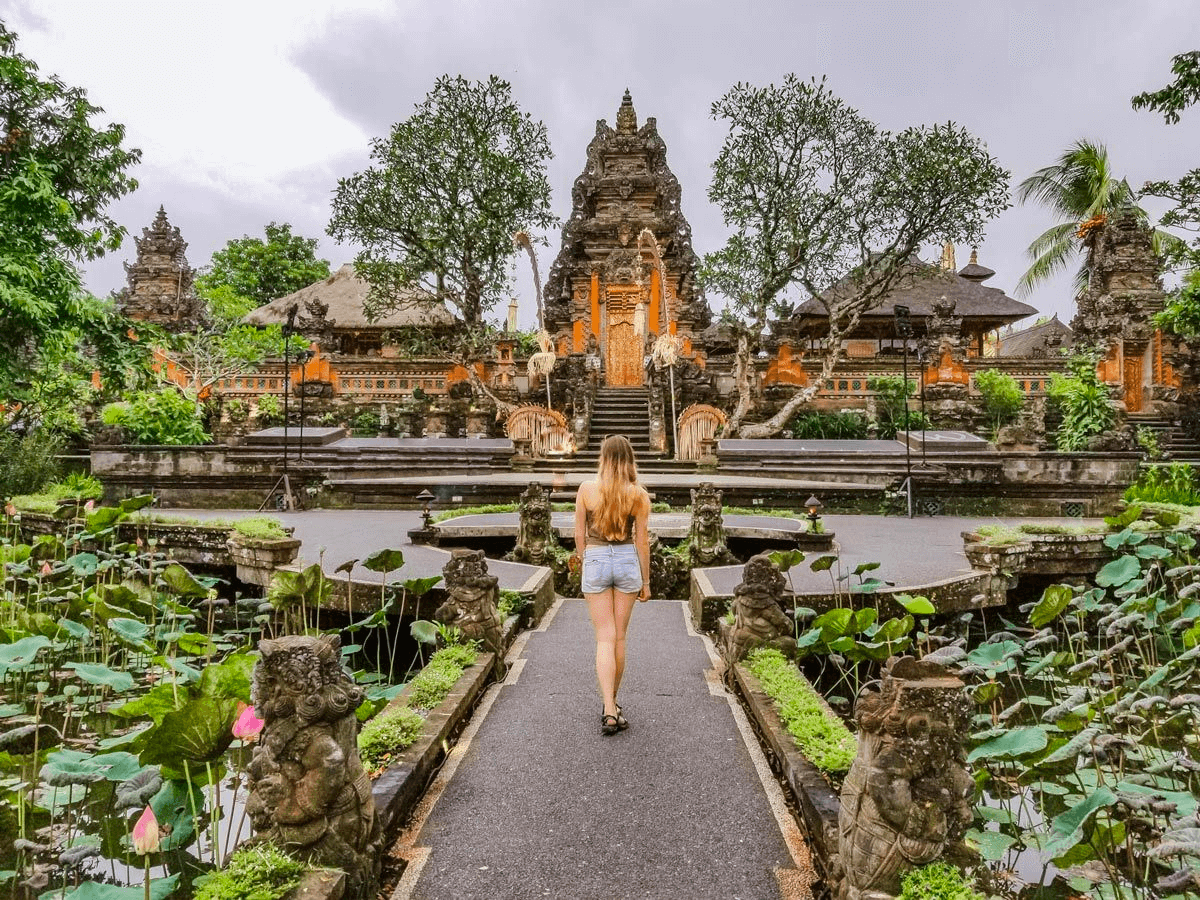
The Puri Saren Ubud, commonly known as the Ubud Royal Palace, is a historical and cultural monument in the middle of Ubud. The palace was built in the early nineteenth century and housed the Ubud royal family until the 1940s.
The palace is famous for its one-of-a-kind and ornate architecture, which combines Balinese and European design elements. Beautiful gardens, exquisite carvings, and intricate stone sculptures surround the palace grounds, highlighting the island’s rich creative legacy.
Guests can wander the palace grounds and observe the spectacular architecture and decor. The palace also includes a museum with a collection of historical items and art pieces that provide insight into Bali’s rich cultural history.
The traditional Balinese dance performances conducted in the evenings are one of the palace’s highlights. These performances highlight the island’s colorful culture and are a must-see for tourists to Ubud.
Visitors should allow at least an hour or two to explore the palace and its grounds. The palace also provides various photo opportunities, so tourists should bring their cameras to capture the spectacular architecture and decor.
Ubud Market
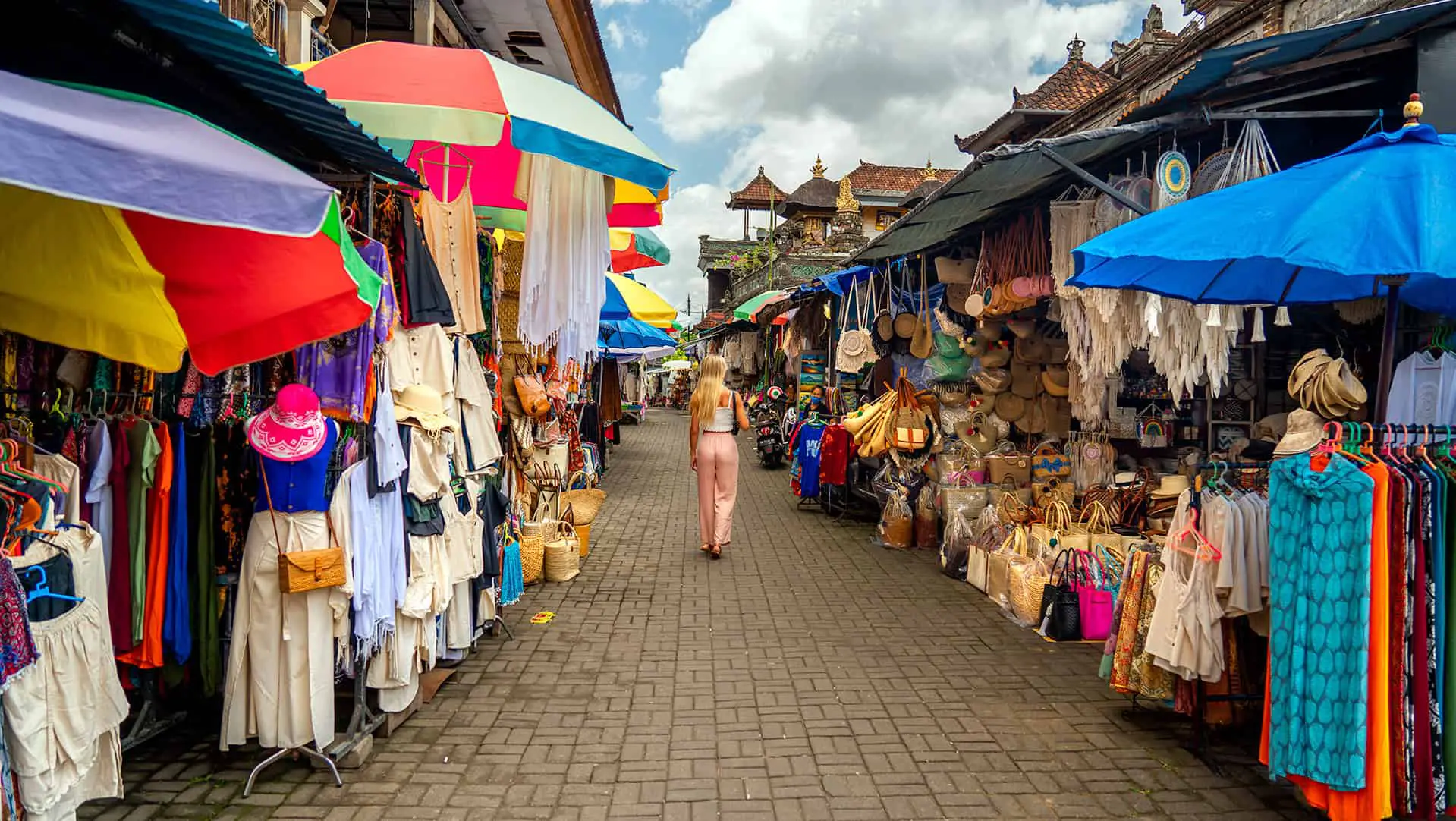
Ubud Market is a vibrant and bustling market in the heart of Ubud. A market is a popular place for tourists looking to buy souvenirs and local handicrafts.
The market offers a wide range of products including traditional Balinese clothing, batik fabrics, jewelry, wood carvings, and handicrafts. Visitors can browse the stalls and find unique and authentic souvenirs to take home.
The market is divided into two areas of the traditional market and the art market. A traditional market is located in front of the market and stocks local produce and household goods. The Art Market is located behind the market and sells traditional handicrafts and souvenirs.
Visitors should allow at least 1-2 hours to explore the market and peruse the stalls. The market can get very crowded, so visitors should be prepared to avoid crowds and bargain with vendors.
When shopping at the market, visitors should be prepared to bargain with vendors to get the best prices for their purchases. It’s also important to keep an eye on your belongings and watch out for pickpockets in crowded markets.
Overall, Ubud Market is a must-see for anyone wanting to experience Bali’s vibrant culture and purchase unique souvenirs and handicrafts. The market offers a glimpse into the island’s rich artistic heritage and a visit We provide customers with an unforgettable shopping experience.
Looking for a way to experience the beauty, culture, and magic of Bali? This Ubud tour is carefully crafted to take you on a journey through some of the most enchanting and memorable locations in the region.
Don’t miss out on this once-in-a-lifetime experience. Book the Ubud tour now and get ready for an adventure you’ll never forget!
Ubud Tours Itinerary
08:00 – Pick up at the hotel
09.30 – Watching Barong and Keris and Dance Performance (Trance Dance)
11.00 – Visit Celuk Village for Traditional Gold and Silver Smith
12.00 – Visit Ubud Tegenungan Waterfall
13.00 – Enjoy Lunch in Ubud
14.30 – Visit Ubud Tegalalang Rice Terrace
15.30 – Visit Ubud Monkey Forest
16.00 – Visit Ubud Royal Palace
16.30 – Visit Ubud Market
17.30 – Back to the hotel
18.30 – Arrive at the hotel
Area Covered for Pick Up
Seminyak, Legian, Kuta, Nusa Dua, Jimbaran, Pecatu, Sanur, Ubud, Canggu, Denpasar, Benoa Harbour, Airport.
Please contact us for pick up in the different area.
Booking and Payment
- Fill in and submit the booking form
- Payment is Cash to your driver
1 day
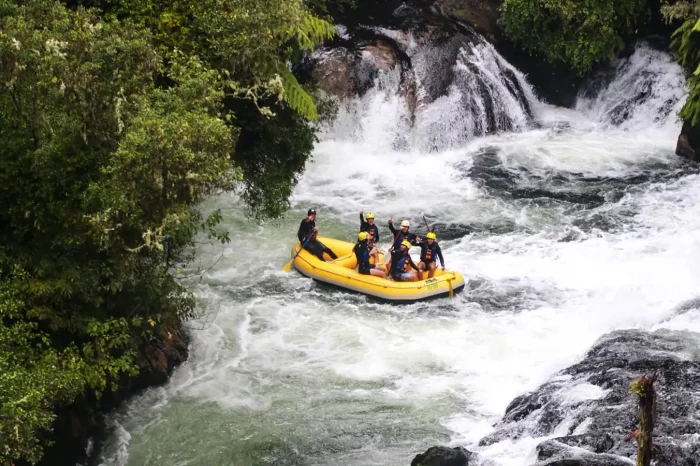
From IDR 250K
Ayung River Rafting Ubud Tour
Ayung River Rafting Ubud Tour is a popular tourist activity that offers a thrilling adventure through the rapids of Bali’s longest river. Located in the heart of Bali, this activity is ideal for those seeking an exciting and fun-filled experience amidst the island’s natural beauty. The journey is an unforgettable experience as participants paddle through lush rainforests, cascading waterfalls, and beautiful gorges. Ayung River Rafting in Ubud promises a unique and adventurous way to explore Bali’s beautiful scenery while also providing a great workout and a sense of achievement.
Ayung River Rafting Ubud Tour promises a thrilling experience full of adventure, natural beauty, and adrenaline. Participants can feel the rush of adrenaline as they traverse the river’s Class II and III rapids, surrounded by spectacular scenery such as tumbling waterfalls, lush green woods, and breathtaking gorges. The journey also provides a unique opportunity to discover Bali’s natural splendor, where travelers can see exotic animals such as monkeys, birds, and fish. The event is ideal for individuals looking for an adventure in the great outdoors and gives an unforgettable experience that will be remembered for a lifetime.
Tour details
Duration of the tour
The duration of the Ayung River Rafting Ubud Tour typically ranges from 2-3 hours, depending on the chosen package and itinerary. This includes time spent on preparation and safety briefing, transportation to and from the river, and the actual rafting experience. However, it’s important to note that the duration may vary depending on factors such as weather conditions, river flow, and the pace of the participants. Some tours also include additional activities such as visits to nearby waterfalls or stop for lunch, which can extend the duration of the tour.
Rafting route
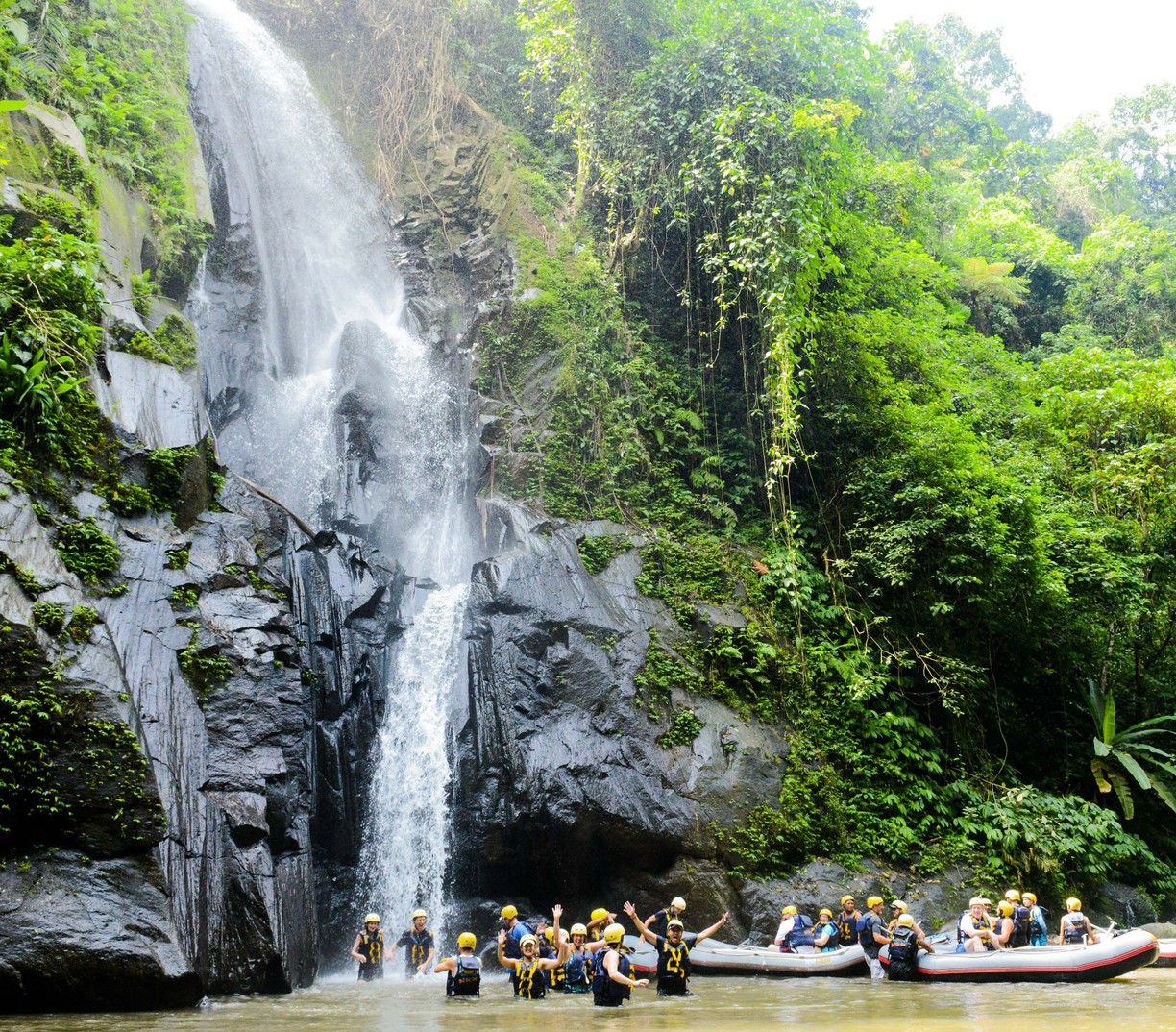
The Ayung River Rafting Ubud Tour route covers a distance of about 10 km in class II to III rapids. The route takes participants through breathtaking natural landscapes, including lush rainforests, cascading waterfalls, and scenic canyons.
The journey begins on a calm river, giving participants time to familiarize themselves with the equipment and paddling. Further along the route, participants will encounter thrilling rapids that will test their paddling skills and provide an adrenaline rush.
Along the way, participants will also have the opportunity to enjoy the natural beauty of Bali, along with the chance to catch a glimpse of exotic wildlife such as monkeys, birds, and fish. Participants can also take a break from rafting to swim in the refreshing river water or bathe in a waterfall.
The Ayung River Rafting Ubud Tour Route also has several attractions, including a short trek to a trailhead where participants can enjoy panoramic views of the surrounding countryside.
Overall, the route offers an exciting and unforgettable experience, showcasing the natural beauty of Bali’s longest river.
Safety precautions and requirements
The Ayung River Rafting Ubud Tour is generally safe, but it’s important to follow safety precautions to ensure a safe and enjoyable experience. Some common safety precautions and requirements include:
- Age limit: Minimum age requirement of 7-8 years old.
- Physical fitness: Participants should be physically fit and in good health to be able to paddle through the rapids.
- Swimming ability: Participants should be able to swim to ensure their safety in case they fall off the raft.
- Safety briefing: Before the tour, a professional guide will provide a safety briefing that covers the proper use of equipment, paddling techniques, and emergency procedures.
- Safety equipment: Participants must wear a life jacket and helmet at all times during the tour.
- Weather conditions: The tour may be canceled or rescheduled in case of extreme weather conditions, such as heavy rain or flooding.
- Follow instructions: Participants must follow the instructions of the guide and be alert during the tour to avoid accidents.
- Medical conditions: Participants with medical conditions such as heart problems, pregnancy, or recent surgeries should consult with their doctor before taking the tour.
It’s important to note that participants should always follow the guidelines provided by the tour operator to ensure a safe and enjoyable experience.
What to wear and bring
It is important to bring appropriate clothing and necessary items to enjoy your Ayung River Rafting Tour in Ubud comfortably. Here are some tips on what to wear and what to bring during your tour.
- Clothes: Please come in clothes that you don’t mind getting wet. Quick-drying clothes such as swimsuits, rash guards, thin T-shirts, and shorts are recommended. Avoid clothes that can get heavy when wet, such as jeans and cotton shirts.
- Footwear: Wear sturdy footwear with good grips, such as sandals or sneakers. Avoid wearing flip-flops or open-toed shoes.
- Sunscreen: Please apply sunscreen to all exposed skin prior to the tour. Wear a hat, sunglasses, or a visor to protect your face from the sun.
- Waterproof bag: Bring a waterproof bag to store valuables such as cameras, mobile phones, and wallets.
- Towel: Please bring a small towel to wipe your body after the rafting experience. Water: Bring a water bottle to stay hydrated during the tour.
- Change of clothes: Please bring a change of clothes after the tour.
- Repellent: Apply repellent to prevent insect bites.
It is also important to follow the tour operator’s safety guidelines and follow the tour guide’s instructions. By following these tips, you can make Ayung River rafting a safe, comfortable, and enjoyable experience on your Ubud tour.
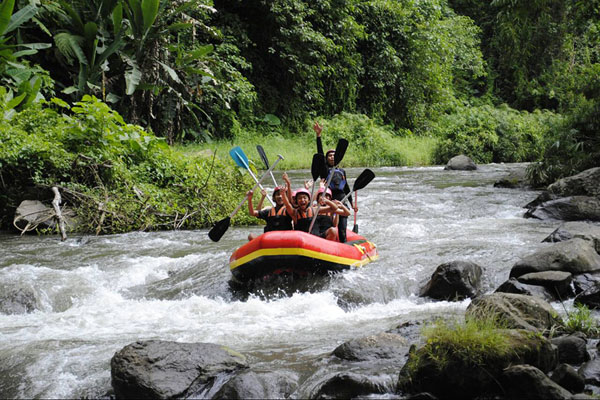
Booking The Ayung River Rafting Ubud Tour is a great way to experience the natural beauty and excitement of Bali. With breathtaking scenery, challenging rapids, and opportunities for adventure, Ayung River Rafting is an experience you won’t soon forget.
Book this tour to explore Bali’s lush rainforests, canyons, and waterfalls from a unique perspective. Feel the adrenaline rush as you navigate the exhilarating rapids of the Ayung River and feel the refreshing water on your face.
Whether you are a seasoned adventurer or a beginner, Ayung River Rafting in Ubud is an experience suitable for everyone. With experienced guides, high-quality equipment, and a commitment to safety, you can enjoy your trip with peace of mind while leaving the details to the professionals.
If you are looking for an unforgettable adventure in Bali, book The Ayung River Rafting Ubud Tour now. You will create memories that will last a lifetime and have experiences that you will always cherish.
Tour Prices :
1 Person : IDR 600.000
2 Persons : IDR 375.000/ person
3 Persons : IDR 300.000/ person
4 Persons : IDR 275.000/ person
5 Persons or More : IDR 250.000/ person
Area Covered for Pick Up
Seminyak, Legian, Kuta, Nusa Dua, Jimbaran, Pecatu, Sanur, Ubud, Canggu, Denpasar, Benoa Harbour, Airport.
Please contact us for pick up in different area.
Booking and Payment
- Fill in and submit the booking form
- Payment is Cash to your driver
1 day
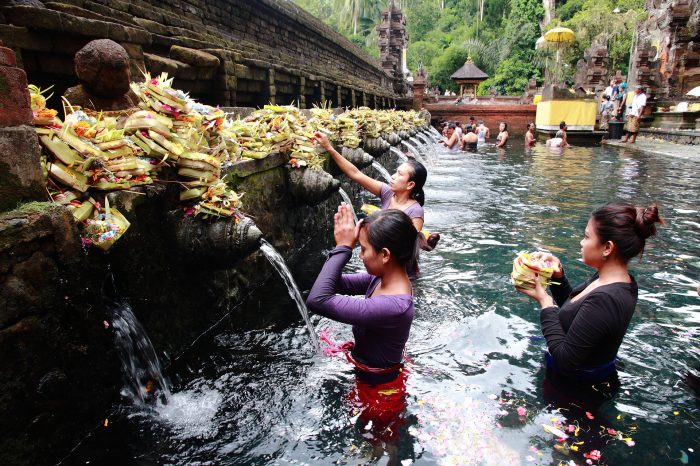
IDR 650K
Kintamani Tour Bali
The Kintamani Tour package is a must for anyone visiting Bali, Indonesia. This tour visits some of the most beautiful and culturally significant places in Bali. From traditional performances of barong and keris dances to exploring ancient temples, this tour offers a rich and authentic Balinese experience.
The tour begins with a visit to Barong and Keris’s dance performance. This traditional Balinese dance represents the eternal struggle between good and evil. A must-see performance that showcases Bali’s rich culture and traditions.
Next, the Kintamani Tour will take you to Tegallalang Rice Terrace in Ubud, a beautiful rice terrace in the heart of Bali. A perfect place for nature lovers and photographers. Stroll through the rice terraces and enjoy the stunning scenery while learning traditional Balinese farming methods.
The next stop on the tour is Kintamani village. Here you will enjoy a traditional Balinese lunch with breathtaking views of Batur Volcano and Lake Batur. It’s a great opportunity to taste local Balinese cuisine while enjoying the beautiful scenery.
The tour also includes a visit to the temple of the sacred spring Tirta Empul. The temple is known for its holy water, which is said to have healing properties. Visitors can take a dip in the sacred waters and participate in a traditional Balinese purification ceremony. The final stop of the tour is Goa Gajah Temple, an ancient temple set in a beautiful rainforest. Known for its intricate stone carvings, the temple is believed to have been built in the 11th century.
Kintamani Tour package is an excellent way to experience the rich culture and natural beauty of Bali. From the performance of traditional barong and keris dances to the stunning views of Ubud’s Tegalalang Rice terrace, this tour offers a unique and authentic Balinese experience.
Place to Visit
Barong and Keris Dance Performance

One of the most significant cultural events on the island is the Barong and Keris dance performance, a traditional Balinese dance. Whether there are formal ceremonies, festivals, or special occasions, this dance performance is typically presented in temples and public spaces.
Balinese mythology attributes good to the mythological Barong, while evil is symbolized by the ancient Indonesian dagger Keris. Barong and Keris are engaged in combat in the dance, and Barong is attempting to save the audience from Keris’ maliciousness. Character introductions are usually followed by a conflict between Barong and Keris at the start of performances.
The dance is complemented by traditional Balinese music performed on gamelan instruments, which adds to the performance’s enchanted mood. The dancers move gracefully and in unison while donning beautiful costumes.
Tegalalang Rice Terrace

The Tegalalang Rice Terrace is one of Bali’s most famous and beautiful landscapes. The island’s long history of rice farming is attested to by the rice terraces, a cultural icon of Bali.
A complex irrigation system that has been passed down through generations of Balinese farmers was used to build the rice terraces. The method uses small channels to redirect water from rivers and streams into rice paddies. The procedure makes sure that the rice paddies have the right amount of water and nutrients for growing strong crops.
Visitors to the Tegalalang Rice Terrace have the chance to tour the terraces and discover how rice is traditionally farmed. The scenery makes for a beautiful backdrop for photos, thus there are numerous photo chances accessible.
There is an optional activity—the traditional Balinese swing—available for those seeking a distinctive experience. Visitors may swing above the rice terraces and take in the beautiful views from a unique vantage point thanks to the swing’s bamboo and rope construction.
It is advised to set aside at least an hour or two to tour the rice terraces and appreciate the natural beauty of the area. Also close are a number of local cafes and gift shops where tourists may try local food and buy souvenirs.
In general, those who are interested in Balinese culture and natural beauty should visit the Tegalalang Rice Terrace. It’s the ideal place to unwind and interact with the island’s rich cultural heritage thanks to its fascinating history, beautiful landscapes, and intriguing optional activity.
Kintamani Village
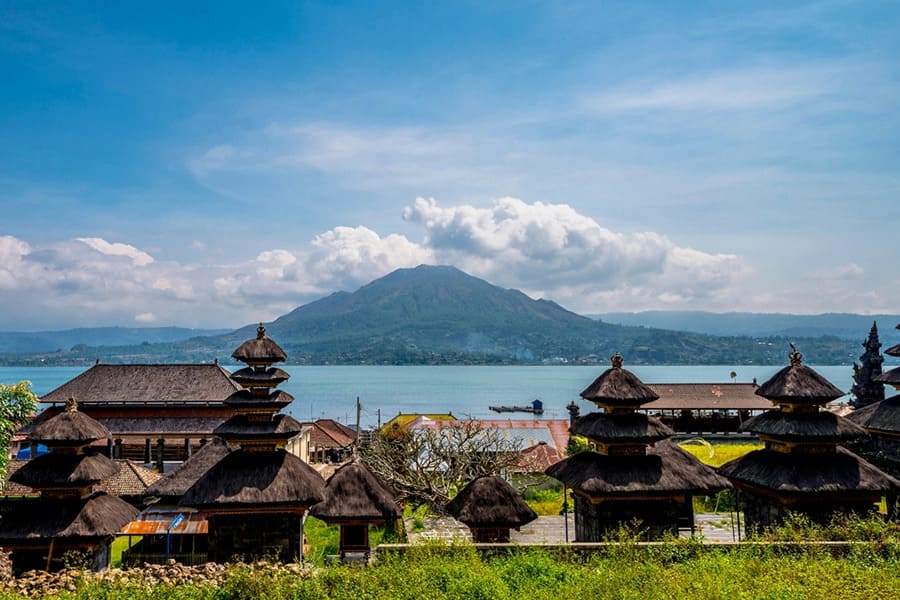
A small, traditional village called Kintamani Village may be found in Bali’s Kintamani district. The community is renowned for its outstanding natural surroundings, including breathtaking views of Mount Batur and Lake Batur, as well as its vibrant culture and history.
The Bali Aga people, one of Bali’s first residents, reside in the village and have managed to maintain their traditional way of life and rituals despite the area’s tremendous growth in tourism. Exploring the hamlet’s winding alleyways, going to the nearby markets, and taking in daily village life are all great ways for visitors to Kintamani Village to get a sense of the community’s distinctive culture and traditions.
Take a guided tour of the village, where tourists may learn about the history, culture, and way of life of the community from a local guide, as it is one of the most well-liked activities in Kintamani Village. The famed “babi guling” (roast suckling pig) and “ayam betutu” (chicken roasted with Balinese spices), which are available in neighborhood warungs, are only a couple of the traditional Balinese dishes that tourists can sample (small eateries).
Kintamani Village is renowned for its woodcarving and weaving traditions, and tourists can buy handcrafted fabrics and sculptures from regional craftspeople if they have an interest in handicrafts.
Visitors can get a rare look at Bali’s traditional culture and way of life at Kintamani Village. Guided tours of the village, tasting local cuisine, shopping for handcrafted fabrics and carvings, and discovering local markets are all optional activities.
Tirta Empul Holy Spring Temple
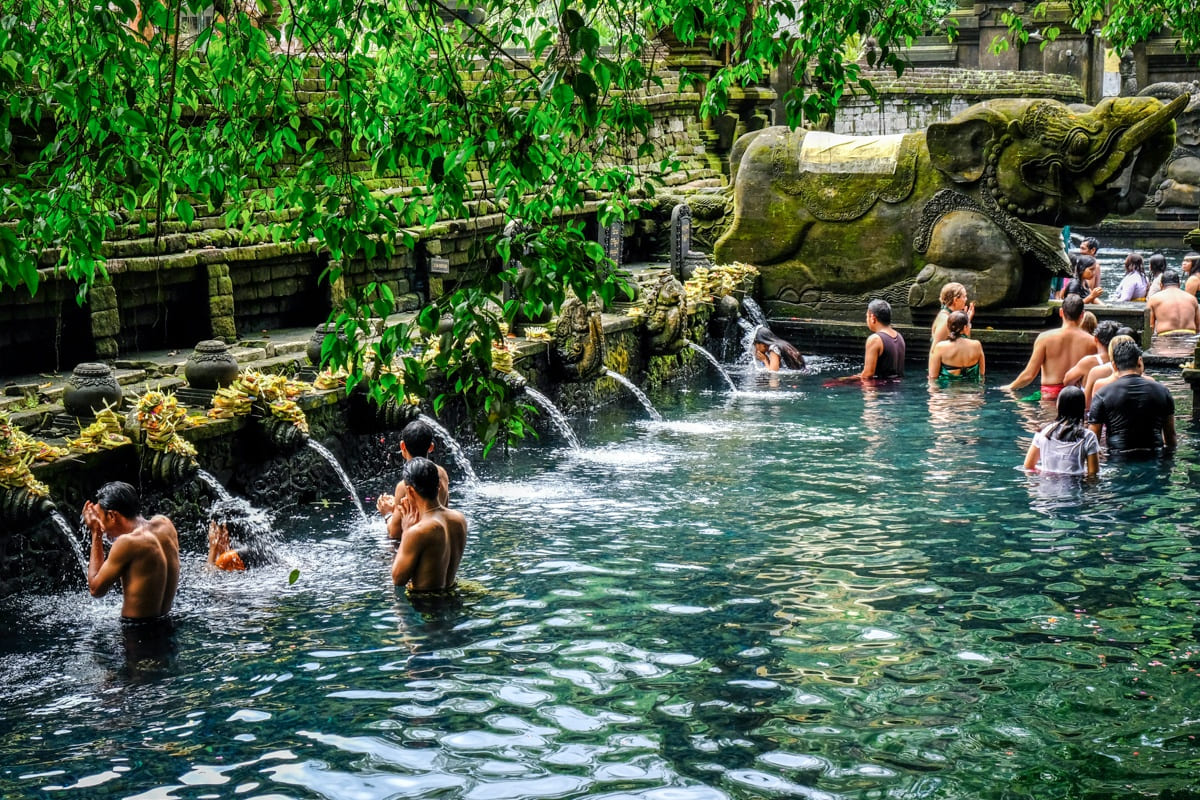
Tirta Empul Holy Spring Temple is a Hindu Balinese water temple located in the village of Tampak Siring, Bali. The temple was founded in 960 AD during the Warmadewa dynasty and was expanded during the rule of the Udayana dynasty in the 11th century.
The temple complex consists of three main sections: Jaba Pura (front yard), Jaba Tengah (central yard), and Jeroan (inner yard). Visitors must first pass through the Jaba Pura, which is the entrance to the temple. In the Jaba Tengah, visitors can see two pools of holy spring water where devotees perform a purification ritual called melukat.
The holy spring water is considered to have magical and curative powers. Balinese Hindus believe that water has the power to cleanse their soul and cure their illnesses. The temple’s name “Tirta Empul” means “holy water spring” in Balinese.
During the guided tour of the temple, visitors will be able to witness the purification ritual performed by devotees. The ritual involves a series of bathing and prayer sessions in the holy spring water. Devotees must wear traditional Balinese clothing and perform the ritual in silence to respect the sanctity of the temple.
Visitors can also see the temple’s unique architecture and intricate carvings, which depict scenes from Hindu mythology. The temple is surrounded by a beautiful garden with a lotus pond and is set against a backdrop of lush green hills.
The Tirta Empul holy spring temple is a significant cultural and spiritual site in Bali, offering visitors a glimpse into the Balinese Hindu culture and their beliefs in the magical powers of holy spring water. A guided tour of the temple is a must-do experience for those seeking to learn more about Bali’s unique cultural heritage.
Goa Gajah Temple (Elephant Cave Temple)
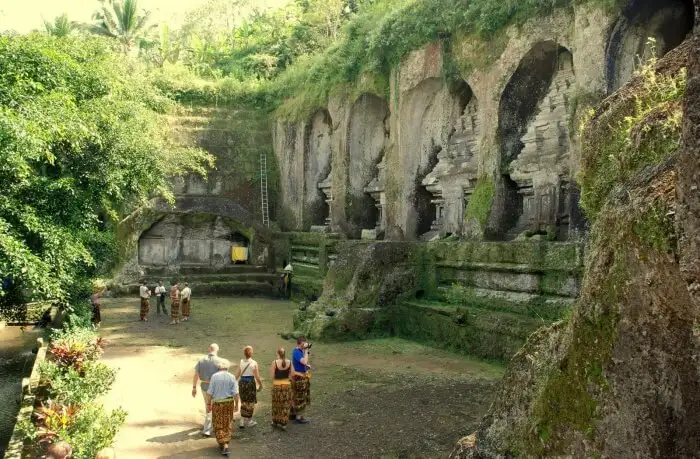
Hindu temple Goa Gajah Temple, often referred to as Elephant Cave Temple, is situated in Bedulu village, Bali. During the rule of the Balinese kingdom of Bedahulu, the temple is thought to have been constructed in the ninth century.
The history and significance of the temple are unknown, however, it is thought that Hindu priests used it as a place of meditation. The frightening beast that is carved into the cave’s entrance is thought to represent the underworld. There are several little recesses inside the cave that are thought to have been used for meditation.
The Indonesian name for the temple, “Goa Gajah,” means “Elephant Cave” in English. Unfortunately, the temple is devoid of any real elephants. The Petanu River, once known as the Elephant River, flows adjacent to the temple, which is thought to be where the name came from.
The temple’s exquisite sculptures are one of its key draws. Two dwarf statues stand guard at the entrance to the temple, while carvings of several Hindu gods and goddesses adorn the entrance to the cave. Moreover, there are several symbols and scenes from Hindu mythology carved into the cave’s inside.
Visitors may explore the cave and its surroundings while taking a guided tour of the temple. The tour will provide information about the temple’s background and importance as well as the significance of each carving.
A Buddhist stupa and a swimming pool are two other buildings that visitors may observe within the temple complex. Visitors may take a leisurely stroll around the verdant garden that surrounds the temple to take in its stunning surroundings.
A unique and remarkable temple, Goa Gajah Temple provides tourists with a window into Bali’s rich cultural past. Anybody interested in Balinese history and culture must visit the temple because of its elaborate carvings and enigmatic past. To truly comprehend the temple’s significance and beauty, a guided visit is strongly advised.
Take advantage of our Kintamani Tour to discover Bali’s cultural and natural attractions! See the majestic Tegalalang Rice Terrace, take in the serenity of Tirta Empul Holy Spring Temple, and be mesmerized by the Barong and Keris Dance.
Enjoy a scenic journey through Kintamani Village while learning about the mysticism and history of Goa Gajah Temple, also known as the Elephant Cave Temple. You will have an experience you won’t forget thanks to our skilled guide. Make Kintamani Tour reservations right away to make lifelong experiences!
Kintamani Tour Itinerary
08:00 – Pick up at the hotel
09.30 – Watching Barong and Keris Dance Performance
11.00 – Visit Tegalalang Rice Terrace
13.00 – Visit Kintamani Village
13.30 – Enjoy Lunch at Kintamani
15.00 – Visit Tirta Empul Holy Spring Temple
16.30 – Visit Goa Gajah Temple (Elephant Cave Temple)
17.30 – Back to the hotel
18.30 – Arrive at the hotel
Area Covered for Pick Up
Seminyak, Legian, Kuta, Nusa Dua, Jimbaran, Pecatu, Sanur, Ubud, Canggu, Denpasar, Benoa Harbour, Airport.
Please contact us for pick up in the different area.
Booking and Payment
- Fill in and submit the booking form
- Payment is Cash to your driver
1 day
